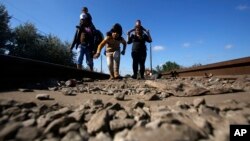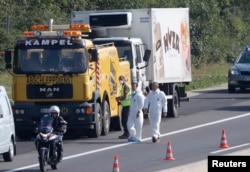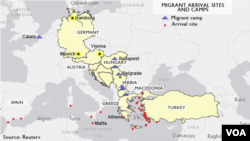European police units responsible for monitoring social media sites for terrorist activity are expanding their focus to find people traffickers. They are looking for traffickers advertising their services online while law enforcement officials warn that drug smuggling rings have switched to smuggling refugees and migrants.
European officials admit they are just starting to piece together a complete picture of the far-flung organized crime networks that are profiting from the misery of sub-Saharan migrants seeking a better life and Syrian, Iraqi and Afghan refugees fleeing war and persecution.
With the profits from human smuggling now rivaling those of narcotics trafficking and the black market arms trade, more criminal gangs are getting involved, officials warn.
Last week, Rob Wainwright, head of Europol, a European police agency, told an Irish radio station that an estimated 30,000 people were involved in human smuggling gangs, most acting as facilitators.
His agency is pursuing 1,400 cases of human smuggling, he said.
In Libya, people traffickers can make about $150,000 on a boat crowded with 150 migrants — some wooden trawlers used by the smugglers can pack aboard double that number. In Turkey, larger unseaworthy old cargo vessels — so-called ghost ships because the crews abandon the vessels as they near Europe’s shoreline — can net nearly $4 million per trip in profits.
“With migrants facing dangerous and deadly situations, the need to act is urgent,” according to Yury Fedotov, head of the United Nations Office on Drugs and Crime. “Overcrowded boats, makeshift vessels, and unguided cargo ships which are prone to capsizing, sinking or being abandoned are just some of the perils being faced: Coupled with this humanitarian concern are the profits being generated by organized crime.”
In a classified 10-page document leaked in May by the organization Wikileaks, European defense chiefs warned their political superiors that more intelligence was needed on smuggling networks and the “trafficking business models, financing, routes, places of embarkation, capabilities and identities.”
The chiefs recommended using “the full range of surveillance and intelligence capabilities available to member states” to identify the smuggling networks and called for greater cooperation with third countries in the Middle East and Africa in order to “disrupt trafficking networks and bring the perpetrators to justice and seize their assets.”
At an anti-smuggling conference scheduled for November in Malta with African leaders, European officials will demand better cooperation and a streamlining process for sharing intelligence on the trafficking gangs.
The effort to assemble the jigsaw puzzle of the criminal networks has taken on a new urgency since the drowning death of three-year-old Syrian Alan Kurdi — he died along with other family members off the coast of Turkey — and the suffocation deaths of 71 refugees and migrants who were found in the back of an airless truck on an Austrian highway.
After the bodies of the refugees were found in the truck abandoned on the motorway, Austrian and Hungarian authorities arrested several people, including three Bulgarians and an Afghan. But, police chief Hans Peter Doskozil admits those arrested in Austria are just lowly operatives and not the bosses of the trafficking gang involved.
The EU boosted a naval mission against people smugglers in the Mediterranean in July, and much of the intelligence-gathering phase now underway is to generate information for later military action against traffickers’ boats off the Libyan coast. But identifying the networks is a challenge itself and the dismantling of the criminal networks bringing migrants across the Mediterranean or Syrian refugees via Turkey is going to be hard to pull off — as hard as ending the drug trade, officials acknowledge.
Daunting problem
The scale of the criminal activity and the geographical span from Morocco in the West to the Balkans and Turkey is daunting.
Investigators have not only to build a picture of the smugglers in Africa from the main source countries and those operating in Turkey but also the gangs handling the Mediterranean crossings from Libya to Italy and from Turkey to Greece. Then they have to identify the gangs handling the land routes to the more prosperous north European states once the refugees and migrants have landed.
And with older criminal gangs — including Italian, Serbian, Albanian and Turkish mafias — involved on both sides of the Mediterranean, the task looks even harder. Intelligence-sharing operations rooms have been established in Sicily and in Piraeus, Greece.
On the North Africa side of the Mediterranean, the gangs involved have been plying the trade for years.
“The smuggling networks are made up of organized crime gangs that are highly experienced in people-smuggling and have been human traffickers for years,” says Lt. Abdul Naser Hazam, who heads an 350-person investigative unit in the Libyan capital, Tripoli.
He says there are many smuggling operations stretching from the coast of Libya back to the main source countries in Africa — Chad, Mali, Somalia, Niger, Eritrea, Nigeria, The Gambia, Ghana and Senegal. Hazam likens the trade to a conveyor belt overseen by big bosses and with gang leaders being paid off at different stages of the journey, not dissimilar to some of the more complex Mexican and Colombian drug cartels.
The networks are intertwined with border tribes — including the powerful Awlad Ali tribe straddling the Libyan-Egyptian border in the east, and in the west, the Nwayel tribe.
With Libya torn by conflict between rival governments, Libyan police and coast guard officials have been hampered in their efforts to combat the smuggling trade — they lack resources and manpower. They say they suspect an Italian mafia involvement in the smuggling.
Col. Rida Benissa, who directs coast guard operations from the Libyan city of Misrata, told VOA that Italian fishing vessels used in the past by Mafia groups linger close to the Libyan shore to help guide smugglers’ vessels. And he claims he has other intelligence from phone intercepts indicating that Italian criminals are working with the smugglers — a cooperation built on an old-time trade of gasoline for whiskey.
Organized crime appears increasingly veined with the registration and land movement of migrants and refugees once they are in Europe.
Anti-mafia prosecutors in Catania in Sicily are investigating links between the Cosa Nostra and public officials overseeing migrant camps. In raids in June, Italian police arrested 44 known criminals and senior government workers, saying that the mafia was involved at various levels of migrant management — from registration to the running of the camps and the settling of migrants in Italian towns and villages.
Police claimed also that the mafia was forcing migrant women into prostitution rings. And there are concerns about the fate of nearly 5,000 migrant children, who, according to Italy’s Foreign Ministry, have disappeared from reception centers across the country in the past year.
Rights groups worry the children have been sucked into the criminal underworld and may have been trafficked for sex or sold for labor exploitation.











